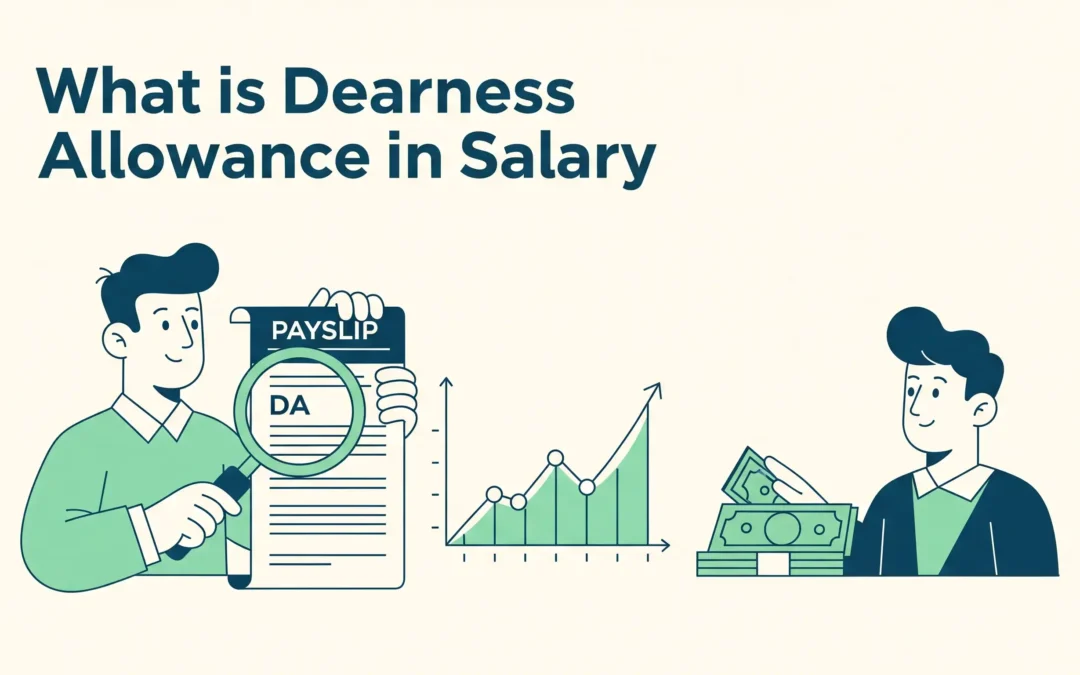Government employees are entitled to many benefits. Dearness Allowance is one of them. Individuals often fail to understand their salary break-up in a proper manner. It is mandatorily included in their pay structure. But are all government employees eligible for it? How is it calculated?
This article will help you answer all these questions that you may have in mind. It will state the eligibility criteria for your clear understanding, along with the types of dearness allowance available.
What is Dearness Allowance?
The government gives its employees and pensioners the Dearness Allowance (DA), a cost-of-living adjustment, to help them deal with the inflation-driven increases in the price of goods and services. It is a set percentage of the base pay that is updated on a regular basis to prevent inflation from depleting employees’ purchasing power.
Key Features:
- Paid to pensioners, central and state government employees, and Public Sector Undertaking (PSU) workers, with applicable variations.
- Intended to counteract the effect of inflation on workers’ earnings.
- Expressed as a percentage of the base pay.
- DA for central government employees is typically revised twice a year (in January and July), while Industrial Dearness Allowance (IDA) for PSU workers is updated quarterly.
- Subject to income taxation under the Income Tax Act.
- Employees of the central and state governments are subject to different DA rates.
Types of Dearness Allowance
Let us look at the types of dearness allowance:
1. Industrial Dearness Allowance (IDA):
Workers of Public Sector Undertakings (PSUs) such as BHEL, ONGC, NTPC, and others are eligible to receive Industrial Dearness Allowance (IDA). In order to account for short-term inflationary trends, it is updated quarterly, or every three months. The Consumer Price Index for Industrial Workers (CPI-IW) serves as the basis for IDA calculations.
Features:
- PSU employees (not central government employees) can use it.
- January, April, July, and October are the four times a year that it is revised.
- directly impacted by changes in the CPI-IW.
- May rise or fall based on inflation.
- Aids in keeping industrial workers’ wages at their true value.
2. Variable Dearness Allowance (VDA)
Workers in the organised sector covered by the Minimum Wages Act are the primary recipients of the Variable Dearness Allowance (VDA). It is updated every six months in accordance with CPI and is a component of the minimum wage structure established by the Labour Ministry.
In order to shield low-wage workers from the effects of inflation, VDA is typically paid in addition to the Basic Minimum Wage (BMW).
Features:
- Applicability to unskilled and semi-skilled workers under minimum wage regulations.
- Every two years, in April and October, it is revised.
- A fixed cost-of-living index is used in the calculation.
- Paid more than the minimum wage.
- Protects minimum earnings across various job roles and geographical areas.
Eligibility for Dearness Allowance
1. Employees of the Central Government
DA is available to workers employed by departments such as Income Tax, Railways, and Defence.
2. Employees of the State Government
Every state sets its own DA rates according to budget and inflation. DA is paid to state employees on top of their base salary.
3. Employees of Public Sector Undertakings (PSUs)
PSU employees who work for BHEL, ONGC, and SAIL are eligible for Industrial DA.
4. Pensioners (retired government workers)
Based on their most recent basic salary, retired employees of the federal or state governments receive DA as part of their monthly pension.
5. Members of Parliament and Judges
As part of their compensation and benefits, these officials also receive DA.
How to Calculate Dearness Allowance
Dearness Allowance (DA) is computed as a percentage of the base pay, based on Consumer Price Index (CPI) data. Central government employees and central public sector employees use slightly different formulas involving inflation data:
- For Central Government Employees:
DA(%)= (Average CPI for past 12 months – 115.76)/115.76 x 100
Here, 115.76 is the base index (with base year 2001 = 100).
- For Central Public Sector Employees (Industrial DA):
DA(%)= (Average CPI for past 3 months – 126.33)/126.33 x 100
Here, 126.33 is the base index used.
Example:
- Base salary: Rs. 1,00,000
- DA = 40% (calculated using the above formula)
- DA amount = 40% of 1,00,000 = Rs. 40,000
- Total gross salary = Rs. 1,40,000
The Ministry of Finance or the respective authorities announces DA revisions based on updated inflation data. Generally, a higher inflation rate leads to an increase in DA. DA is a mandatory component of the salary for permanent government employees.
Bottomline
The conclusion can be drawn that dearness allowance makes up a good chunk of the total gross salary. They are calculated based on the CPI and base index. Permanent employees of the central and state governments are eligible for it. It is revised quarterly or semi-annually, depending on the given conditions.
However, temporary or contractual government employees may not be liable for it. It is important to fully understand the breakdown of your salary.


